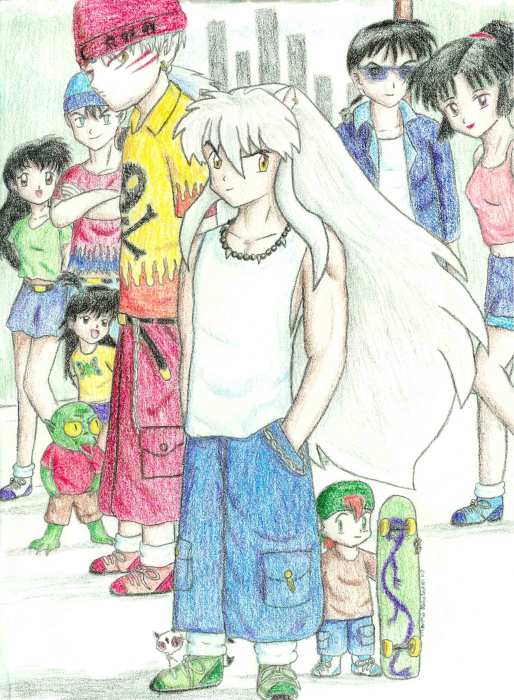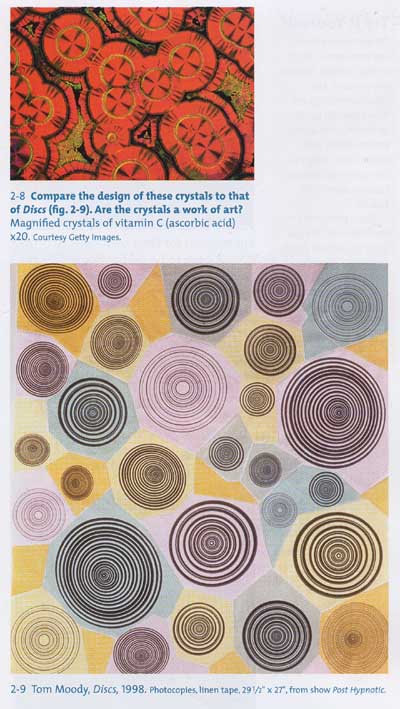View current page
...more recent posts
Three "work in progress" performances by artists from the 2004 Whitney Biennial debuted at the Kitchen last night. Tracy + The Plastics, a one-woman (virtual) band, consisted of Wynne Greenwood seated at a keyboard, playing and conversing with two prerecorded Wynne Greenwoods on DVD. The three are ostensibly sitting around their "band house" performing snippets of songs and having mock-lame arguments about the direction of their music. While frequently funny, Greenwood's passive aggressive slacker-chick persona wore thin after a while: I know this year's Whitney was about the "quest for the adolescent" but her self-absorbed conversation with the video mirror seemed trivial next to the mid-to-late 90s electro-femme performance work it somewhat resembled (e.g. Kristin Lucas, Monotrona). Alex Bag also inevitably came to mind.
Golan Levin's work was tech-intensive and nerdy (maybe it was the lab coat) but also fun and playful. He and his fellow performer Zachary Lieberman each used a combination of overhead and digital video projectors to make semi-abstract shadow-outlines (basically Rayograms) of their hands and other objects, with the overlap of the respective projector arrays creating dramatic color separation effects. The shadows in turn interacted with custom software to synesthetically translate shapes into sounds. A silhouette of a balled fist opening into a two-finger V caused a sequence of chiming musical notes to alter in mid-cascade; three fingers changed the sequence again, and so on. Clunky cut paper objects dropped onto the projector beds had their own unique audio signatures. Manning their opaque projectors like gamers at battle stations, the performers held a back & forth dialogue-cum-duel of changing silhouettes, which was exquisitely timed and quite charming.
Framing the other two performers was Cory Arcangel's "Pizza Party"--a demonstration of how to hack into the Dom1no's website and order pizza using only command line instructions. These green-on-black text-only options, which Arcangel accessed with a Perl script, lurk below Dom1no's (and every other business's) GUI, or graphic user interface, and consist of filling in "y" or "n" next to mushrooms, anchovies, thin crust, etc. and specifying a delivery address. As he walked the audience through the process on a large screen, Arcangel commented drily (but enthusiastically) on the essential uselessness of online commerce, and even greater uselessness of hacking into it, when a simple local phone call would suffice. And although he warned that failure was a possibility in his performance, his confident demeanor when he came back after the other acts told us that our pizzas had arrived.
UPDATE: "Pizza Party, a free text based software package for ordering pizza, or for throwing pizza parties" is available online here.
UPDATE 2: Somebody posted an article about security vulnerabilities in "Pizza Party," the software. No one seems to know if it was satire or not.
Why Do They Hate Us?
Apparently Fox News and the other major media aren't giving the US torture of Iraqi prisoners as much play as it's getting abroad, but please read Seymour Hersh's report in the New Yorker and look at the screen captures from 60 Minutes at the Memory Hole. The clowning of the "guards" around the naked, humiliated prisoners is truly sickening. The government is of course trying to spin this as a "few isolated instances" but the torture was widespread and systemic, according to the military's own reports. Also, our old friends the "contractors" (mercenaries) are once again involved--apparently they dreamed up the "interrogation methods" of sexually abusing Iraqi prisoners. The 60 Minutes photos were pixelated so you couldn't clearly see that the men are being made to masturbate in some of them, while the "guards" jeered. Such activity is much more taboo in the Muslim world than here, and you better you believe this is being discussed all over the globe right now. "Why do they hate us?", you asked after 9/11--look at the pictures. And it wasn't just forced nakedness and "mock orgies." According to a government report cited by Hersh, activities also included:
[b]reaking chemical lights and pouring the phosphoric liquid on detainees; pouring cold water on naked detainees; beating detainees with a broom handle and a chair; threatening male detainees with rape; allowing a military police guard to stitch the wound of a detainee who was injured after being slammed against the wall in his cell; sodomizing a detainee with a chemical light and perhaps a broom stick, and using military working dogs to frighten and intimidate detainees with threats of attack, and in one instance actually biting a detainee.And these weren't just hardened criminals, but people picked up at random stops and torn from their families. So who's accountable? Hersh asks. How about Bush, Rumsfeld, Wolfowitz, the whole decadent, power-mad crew. "The fish rots from the head," as they say.

A killer drawing by GoddessOfWinter: the characters of Inuyasha (which I've not seen) in "normal clothes." It's kind of exciting that anime is being embraced by the jr. high and high school set to the obsessive degree that it is. I'd say kids are pretty perceptive in seeking out quality they're not finding in official culture (i.e., Disney pablum). And this is even with Cartoon Network censoring the original Japanese shows. I'd say I wish I was born later so I could experience this otaku-dom directly, but not if it meant going through secondary school again.
Another piece from homeroom gallery in Munich: Martin Wöhrl's Cowboy Door. Wöhrl did a series of saloon doors copied from various Western movies. The found designs varied a lot more than you would think.

One of my favorite anime videos is Castle of Cagliostro, an adventure film about the master thief Lupin III, directed by Hayao Miyazaki 20 years before he did Spirited Away. The narrative pulls you in from the first frame and never lets go. I recently picked up the DVD and heard the Japanese (with English titles) for the first time. I'm always amazed by the differences in the dubbed versions of anime and the subtitled scripts--the American writers take amazing liberties, I guess because it's just low-culture crap for kids and doesn't matter. But the changes can also work for the film. Here are some examples of the yin and yang of dubbing.
About halfway through Lupin is dumped into a catacomb beneath the Castle. It is filled with the skeletons and rotting bodies of people wearing the armor and raiments of all world history, who have sought the secret of Cagliostro and failed. In the dubbed version, Lupin makes typical dumb American small talk as he walks over the bodies ("place could use some fixing up--some plants, new drapes") and then, after he watches a skeleton wearing a jeweled crown crumble to the ground from the chains that have been holding it to the wall, he looks around the killing ground and says:
"Centuries of political murder, and for what? Rest in peace, you poor bastards."That is a great line, and adds a social dimension to what has been pure escapism up to that point. It foreshadows some of the political machinations driving the story that aren't fully revealed until later. And it gives Lupin a depth we haven't seen before now. The subtitled translation in the Japanese version handles the scene very differently. There is no adlibbing--Lupin is completely silent as he surveys the dead. And his assessment and benediction are much more sombre:
"Killing and killing for 400 years. Rest in peace, all of you."This seems truer to the Japanese tradition of honoring the dead but the line isn't nearly as interesting. Another example, this time where the Japanese subtitle is superior: Earlier in the movie Lady Clarisse steals a car and flees the henchmen of the evil Count Cagliostro, to avoid an arranged marriage with the Count. Lupin and his sidekick Jigen intervene to help her, following in their own car. Gunfire is exchanged and the bad guys are dispatched but then Lupin sees Clarisse slumped over the wheel of her still-speeding car. The music clangs dramatically and in the English dub he yells "She's unconscious!"---which sounds like something a paramedic would say and makes you think she might be seriously injured or even dying, clipped by a stray bullet.
In the subtitled version, though, the line is "She's fainted!" Possibly Mary Mason, the American writer, changed it because she thought Clarisse was too strong a character to swoon at the first sign of trouble. Assuming the subtitled line is faithful to the Japanese, that pc rewrite of Miyazaki is presumptuous. Also, for narrative economy and momentum "fainted" is the better choice here: after your initial shock at seeing Clarisse prostrate in the front seat, when you hear (read) that word you know the movie isn't taking a sudden turn for the tragic--you accept that she'll recover if Lupin can only stop the car. (A main character's surprising brush with mortality doesn't occur till much later.) These little examples make you realize how powerful dialogue can be in shaping what you see with your own eyes.
The 3rd edition of The Visual Experience, a secondary school text by Jack Hobbs, Richard Salome, and Ken Vieth, includes a piece of mine, Discs. It's on p. 15, in a section called The Philosophy of Art:
The authors gave me a break in not asking the thornier, implied question: "If the crystals aren't a work of art, why is Discs?" Fortunately the text covers that elsewhere, explaining the history of abstraction, found objects, etc. (The scan is blurry because every way I tried to sharpen it or tweak the contrast it distorted the piece(s).)
Artist Sally McKay is participating in a show in Toronto, opening April 30, called "Robot Landscapes." In her piece, a small mirror-lined box serves as home to a solar powered robot slowly caroming around inside. Reflected on the inner walls of the box is a continuously looped video of a half-factual, half demented Martian landscape; a kind of Zen foil-ball garden with a dozing, skullfaced inhabitant, who may or may not be inflicting intermittent, flaring image breakdown on the Rover's prying digital eyes. The mirror-diorama is viewed through a window, with nearby headphones chiming musical accompaniment--a kind of lo fi, ambio-melodic soundscape created by yours truly. Sally explains more of the particulars here, and she's also offering a scaled-down version of the 9 inch wide video as a streaming or downloadable online video. A borrowed copy of the interface is below.

click for streaming video
(or option click / right click here for download)
graphics by Sally McKay, music by Tom Moody
Saturday night, April 24, a group of laptop performers convened at vertexList, a newish space in the old Four Walls location in Brooklyn. Video artists picked audio artists as collaborators (and vice versa) and the work seemed as random as the pairings: synergy was only intermittently achieved. The video part of the Jeremy Bernstein/Glomag collaboration (coruscating patterns of finely minced abstraction) showed more subtlety than the clunky audio, and the audio part of the jenghizkhan*/Daniel Vatsky union (mysterious, sexily-filtered ambient industrial keyboards) eclipsed the video's rather generic typography-cum-50s-science-textbook imagery. One moment where everything clicked came during the token "analog segment," when Mike Ballou's super-8 film of a crowd pulling a giant helium-inflated pig through the sky found suitable porcine accompaniment in Brian Dewan's morose vacuum tubular oinks.
A cranky comment: some artbloggers outside NY have said "there's nothing going on here" or words to that effect. That's clearly wrong. The scene is so rich, so multi-layered, so overflowing with good work that gallerygoers have become blase--talking, schmoozing, laughing, flirting, and exchanging business cards during performances. The music and video serve only as a cool clublike backdrop for their networking. This is Williamsburg, after all, where those art school "how to survive as an artist" courses are field-tested en masse. To put it bluntly, the pigs weren't just up there on the screen Saturday.
*aka John Parker

